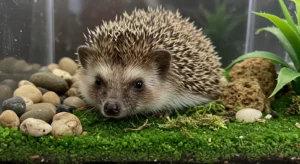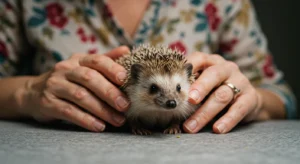Hedgehog Health
Hedgehog Hibernation: Fact or Fiction? What Every Owner Needs to Know
The topic of hedgehog hibernation often confuses new owners. While wild European hedgehogs do hibernate, the commonly kept pet species, the African Pygmy Hedgehog, should **not** hibernate. Attempted hibernation in pet hedgehogs is a dangerous state called torpor, often triggered by incorrect temperatures, and can be fatal if not addressed promptly.
What is Hibernation?
Hibernation is a state of inactivity and metabolic depression in endotherms (warm-blooded animals), characterized by lower body temperature, slower breathing and heart rate, and reduced metabolic rate. It’s an adaptation allowing animals like the wild European hedgehog (Erinaceus europaeus) to survive periods of cold temperatures and scarce food.
Pet vs. Wild Hedgehogs
The crucial difference lies in the species. Pet hedgehogs are typically African Pygmy Hedgehogs, a hybrid derived largely from species native to warmer African climates where true hibernation isn’t necessary. While they retain a physiological *capacity* to slow down their metabolism in response to cold (enter torpor), they haven’t evolved the complex adaptations required for safe, prolonged hibernation seen in their European cousins. They don’t store sufficient fat reserves, nor are their bodies equipped to manage the physiological stresses of deep hibernation and arousal.

The Dangers of Attempted Hibernation (Torpor)
When an African Pygmy Hedgehog gets too cold (typically below 70°F or 21°C, though individual sensitivity varies), it may attempt to enter a state of torpor. This differs significantly from safe hibernation:
- Insufficient Reserves: They lack the fat stores to sustain themselves during prolonged inactivity.
- Organ Strain: The drastic slowing of bodily functions puts immense strain on their organs.
- Immune Suppression: Their immune system becomes compromised, making them highly vulnerable to infections.
- Dehydration & Starvation: They are not adapted to survive without food and water for extended periods in this state.
- Difficulty Arousing: Unlike true hibernators, they may struggle to wake up, potentially leading to death.
Attempted hibernation is a serious medical emergency for pet hedgehogs. Understanding common hedgehog health problems like this is vital.
Causes and Prevention
The primary trigger for torpor in pet hedgehogs is environmental temperature dropping below their safe range.
- Maintain Proper Temperature: The most critical factor. Keep the ambient temperature in your hedgehog’s enclosure consistently between 72°F and 80°F (22°C – 27°C). Use a reliable heat source (like a Ceramic Heat Emitter – CHE) connected to a thermostat.
- Monitor Temperatures: Use two thermometers – one near the heat source and one on the cooler side – to ensure the entire habitat stays within the safe range.
- Avoid Drafts: Position the cage away from drafty windows, doors, or air vents.
- Check Heat Sources Regularly: Ensure heating equipment is functioning correctly. Bulbs burn out, and thermostats can fail.
Warning Signs of Cold: Before attempting hibernation, a cold hedgehog might be lethargic, wobbly, or cool to the touch (especially belly and feet). Address these signs immediately by providing warmth.
Recognizing & Responding to Attempted Hibernation
A hedgehog attempting to hibernate will be:
- Cold to the touch (especially belly).
- Curled in a tight ball and unresponsive or slow to respond.
- Shallow, slow breathing.
- May appear deceased, but subtle twitches might be present.
Immediate Action Required:
- Warm the Hedgehog Gradually: Place the hedgehog directly against your skin (skin-to-skin contact) under your shirt. Use your body heat. **Do NOT use direct heat sources like heating pads or hot water**, as this can cause shock or burns.
- Warm the Environment: Simultaneously, ensure their cage is brought up to the correct temperature (75-80°F / 24-27°C).
- Monitor Closely: Stay with your hedgehog. Warming can take 1-3 hours. They should slowly start to uncurl and become more active.
- Offer Water/Food (Once Alert): Once awake and moving, offer water via syringe and a slurry of their food.
- Veterinary Care: Even if successfully warmed, a vet visit is highly recommended. Attempted hibernation puts significant stress on the body, and underlying issues or secondary infections are common. Discussing optimal hedgehog housing and heating setups with your vet is also wise.
Conclusion: Fiction for Pets
So, is hedgehog hibernation fact or fiction? For the wild European hedgehog, it’s a fact of life. For the pet African Pygmy Hedgehog, it’s a dangerous fiction. Owners must understand that attempted hibernation is not natural or safe for their pets; it’s a life-threatening emergency caused by inadequate temperatures. Maintaining a consistently warm environment is paramount to preventing this critical situation.
Information regarding hibernation characteristics sourced from Wikipedia’s article on Hibernation. Species-specific information relates to African Pygmy Hedgehog care standards.
















